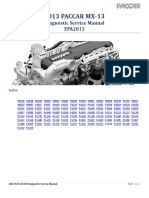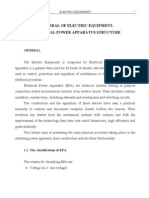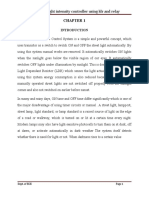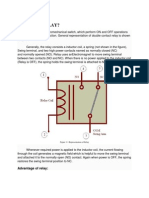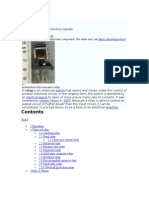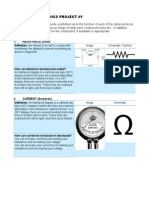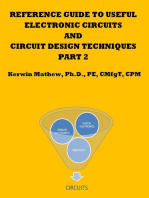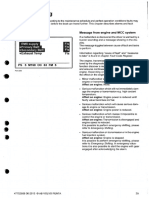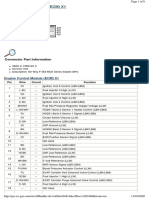Electricity Relay
Electricity Relay
Uploaded by
praneethCopyright:
Available Formats
Electricity Relay
Electricity Relay
Uploaded by
praneethOriginal Title
Copyright
Available Formats
Share this document
Did you find this document useful?
Is this content inappropriate?
Copyright:
Available Formats
Electricity Relay
Electricity Relay
Uploaded by
praneethCopyright:
Available Formats
ELECTRIC RELAYS
CHAPTER-I
1. INTRODUCTION TO ELECTRIC RELAY
Electric relay is the one of the protective device which removes the fault occurs in
electrical devices. In the power system alot of faults nd failures takes place to safe from all this
risks protective devices are used from those electric relay is one the protective device for
electricity continuity.It is designed to trip a circuit breaker when fault is detected. Relay
basically a switch which opens and closes the circuit either electronically or mechanically.
electric relay is invented in 1835 by American electromagnetism pioneer Joseph henry in a
demonstration. It can be used to turn on or off (make or break) circuits, control multiple circuits
with a single signal or control high-power circuits using low-power signalsElectrical relays are
commonly used for switching signals, radio frequencies, high current circuits when using a lower
current circuit, and loads such as resistive, motor, lamp, inductive, and capacitive applications.
This is helpful when an in-line switch or existing circuit does not have the capacity to handle the
required current.
Is it possible to switch on an electric light bulb having a nominal current of 0.3 A with
the assistance of a reed switch relay with a nominal switching current of 1 A? (The correct
answer is NO!) Why does a relay, which has worked well for a year, begin to drone and to
malfunction? (The reason is that the relay has been incorrectly installed with respect to the
vertical line.) Why does the ground fault relayresidual current device) malfunction? Does it mean
that the relay is out of order? (Not necessarily. Most often the reason is changes in insulation
resistance of the equipment under exposure to moisture or high temperature.)
ABIT, Department of EEE Page 1
ELECTRIC RELAYS
CHAPTER-II
2. What is electric Relay
A Relay is an electro-mechanical or solid-state device, used to control a device or a
circuit electrically by applying a control signal to its coil. It is also known by the names
auxiliary, miniature or control relay.
2. ELECTRIC RELAY
A relay is designed as an electrically operated switch. Many relays operate with an
electromagnet to mechanically operate a switch. But other operating principles are also used, like
solid-state relays. Relays functions where it’s necessary to regulate a circuit by a low-power
signal. This peformed with complete electrical isolation between control and controlled circuits,
or several circuits that should be controlled by one signal. Relays are mainly used for circuit
components preferred in telecom applications, gas detector circuits, RF control applications,
Infrared control applications, small volume circuits (gum relay), etc.
ABIT, Department of EEE Page 2
ELECTRIC RELAYS
CHAPTER-III
3. CLASSIFICATION OF RELAY
The relay switch is classified by its number of poles and throws and they include SPST,
SPDT, DPST, DPDT, etc.
3.1 SPST RELAY:
FIG 3.1 SPST RELAY
SPST (Single Pole Single Throw) relays have two terminals that can be connected or
disconnected and two more for the coil. In total, there are four terminals. It can only regulate one
circuit at a time, and it can either open or close it. Controlling of traffic signals can be done using
data acquired from vibration sensors on crossroads. SPST relays act as simple switches for
controlling red-yellow-green signals, which work on higher power supply
3.1.1 SPDT RELAY:
FIG 3.1.1 SPDT RELAY
ABIT, Department of EEE Page 3
ELECTRIC RELAYS
In this type of relays (Single Pole Double Throw), a common terminal connects to either
of two other terminals and two more terminals for the coil. Because of its single-pole design, it
can only control one circuit at a time, but it has two throw locations to conduct. When one circuit
is turned on, the other is turned off, and vice versa. Speed of DC motors or fans can be controlled
by using simple potentiometer or pulse-width modulated (PWM) signals. For AC equivalents,
controlling can be done using power resistors or power semiconductor devices.
Above figure shows how to control the speed of a table fan working on 230V AC supply.
A power resistor can withstand the rated wattage on it. Resistance across shown power resistor
varies from 120 ohms to 60 ohms to 0 ohms, left to right with the right-most terminal fixed.
Depending on temperature, an SPDT relay can be switched on to provide resistance of 120 ohms
or 60 ohms in the circuit, leading to different fan speeds.
3.1.2 DPSTRELAY:
3.1.2 DPSTRELAY
There are six terminals on this type of relay (Double Pole Single Throw). This is the
same as having two SPST relays controlled by a single coil. Two entirely separated circuits can
be controlled by the double pole. There is only one position for a single throw. As a result, a
DPST relay can switch two circuits at the same time by providing a close or open circuit. Above
figure shows how to water a field according to the water content in the soil. Arduino decides the
amount of time and, hence, the amount of water to be pumped in the field, using a DPST relay. A
siren in parallel sounds to indicate pump in on condition. This application is helpful in saving
water.
ABIT, Department of EEE Page 4
ELECTRIC RELAYS
3.1.3 DPDT RELAY:
FIG 3.1.3 DPDT RELAY
There are eight terminals on this relay (Double Pole Double Throw). These have two
change-over terminals, which is the same as having two SPDT relays controlled by a single coil.
Double pole and double throw refer to the fact that it can control two circuits and conduct in two
different directions. Application 4 explains how to control a simple unmanned ground vehicle
(UGV) that moves forwards and backwards depending on input. A DC motor’s direction of
rotation is controlled by alternating the polarities of input voltage. A sensor such as ultrasonic
sensor observes the obstacles and decides whether to move forwards or backwards. Fig. 7 shows
a DPDT relay having two switches controlled by one excitation signal. Switches with polarity of
12V are required for the motor. Direction of motion of the UGV changes accordingly.
ABIT, Department of EEE Page 5
ELECTRIC RELAYS
CHAPTER-IV
4. TYPES OF RELAYS
1. Electromechanical relay
2. Solid state relay
3. PCM Power relay
4. Hybrid relay
5. Latching relay
4.1 ELECTROMECHANICAL RELAY
FIG 4.1 ELECTROMECHANICAL RELAY
An electromechanical relay is a type of relay which function using a magnetic field
produced by an electromagnetic coil when a control signal is applied to it. It is called as
electromechanical since it has moving contacts in the output circuit which are operated by
applying an electrical signal.
ABIT, Department of EEE Page 6
ELECTRIC RELAYS
4.1.1 ELECTROMECHANICAL RELAY: WORKING PRINCIPLE
FIG 4.1.1 ELECTROMECHANICAL RELAY: WORKING PRINCIPLE
An electromechanical relay transfers signals between its contacts through a mechanical
movement. It has three sections viz. input section, control section and output section.
The input section consists of input terminals where a small control signal is to be applied. The
control section has an electromagnetic coil which gets energised when control input signal is
applied to the input terminals and the output section consists of an movable armature and
mechanical contacts – movable and stationary, the movement of the armature makes or breaks
the electrical circuit.
When an input control voltage is applied to the electromagnetic coil, it gets magnetised
and the armature is attracted by the magnetic field produced by the coil. The movable
mechanical contacts are attached to the armature, thus when the armature moves towards the
electromagnet, the contacts closes, making the output circuit switched on. When the control
signal is removed, the armature comes back to its original position by the force of spring, making
output circuit off.
4.2 SOLID STATE RELAY
FIG 4.2 SOLID STATE RELAY
ABIT, Department of EEE Page 7
ELECTRIC RELAYS
Solid State Relays are semiconductor equivalents of the electromechanical relay and can
be used to control electrical loads without the use of moving parts
Just like a normal electro-mechanical relay, SSR’s provide complete electrical isolation
between their input and output contacts with its output acting like a conventional electrical
switch in that it has very high, almost infinite resistance when nonconducting (open), and a very
low resistance when conducting (closed). Solid state relays can be designed to switch both AC or
DC currents by using an SCR, TRIAC, or switching transistor output instead of the usual
mechanical normally-open (NO) contacts.While the solid state relay and electro-mechanical
relay are fundamentally similar in that their low voltage input is electrically isolated from the
output that switches and controls a load, electro-mechanical relays have a limited contact life
cycle, can take up a lot of room and have slower switch speeds, especially large power relays and
contactors. Solid state relays have no such limitations.
4.2 SOLID STATE RELAY WORKING
One of the main components of a solid state relay (SSR) is an opto-isolator (also called
an optocoupler) which contains one (or more) infra-red light-emitting diode, or LED light
source, and a photo sensitive device within a single case. The opto-isolator isolates the input
from the output.
FIG 4.3 SSR CIRCUIT DIAGRAM
The LED light source is connected to the SSR’s input drive section and provides optical
coupling through a gap to an adjacent photo sensitive transistor, darlington pair or triac. When a
current passes through the LED, it illuminates and its light is focused across the gap to a photo-
transistor/photo-triac.Thus the output of an opto-coupled SSR is turned “ON” by energising this
LED, usually with low-voltage signal. As the only connection between the input and output is a
beam of light, high voltage isolation (usually several thousand volts) is achieved by means of this
ABIT, Department of EEE Page 8
ELECTRIC RELAYS
internal opto-isolation. Not only does the opto-isolator provide a higher degree of input/output
isolation, it can also transmit dc and low-frequency signals. Also, the LED and photo-sensitive
device could be totally separate from each other and optically coupled by means of an optical
fibre.
4.4 PCM POWER RELAY
There will be many functions in a car. A computer control all of them. Also, it
manages the engine. However, there will be an engine control module. That will
manage the engine and its related functions.
The Engine Control Module or ECM will monitor the operation. Also, it will
control the power distribution to the fuel and injection systems. It will check the
engine timing, emissions, ignition, exhaust gas circulation, and other
functionalities within your vehicle. However, the ECM will need the power to
transfer it to each system. You will find the power distribution center of a vehicle
under its hood. It controls all the relays and fuses of a car. The PCM power relay or
ECM power relay work as a switch and transfer power to the ECM. However, if
the ignition key turns off, the switches within the PCM power relay will not
receive battery power. As a result, your vehicle will not operate properly.
Also, when a PCM relay stays open, it cannot transfer power to the ECM. Hence,
you cannot turn on and start your vehicle. When it remains closed, the ECM will
receive too much power. That will lead to battery drainage.
ABIT, Department of EEE Page 9
ELECTRIC RELAYS
4.5 WORKING
FIG 4.5 PCM POWER RELAY
The powertrain control module, which is generally abbreviated as PCM, is an automotive
component that combines the engine control unit and the transmission control unit. The
transmission is a huge part of the powertrain, including the engine. Powertrain Control Module
Parts Let’s go into depth about your vehicle’s two parts and how they affect the PCM relay.
Engine Control Unit The engine control unit, also known as the engine control module, is a type
of electronic control unit that controls actuators within the internal combustion engine. The
engine control unit is the brain of an engine and handles various performance and driveability
functions. If the ECM fails, the PCM relay will not work correctly. Its job is to do this by reading
the values produced by various sensors located inside the engine bay. The engine control unit
interprets the data using performance maps and adjusts the engine actuators. Before engine
control units were used, idle speed and ignition timing had to be mechanically programmed.
Internal Combustion Engine The engine control unit’s parts, the actuators, and the
internal combustion engine are crucial to the functioning of the powertrain control module. The
actuators are components of a machine responsible for moving the mechanics within the system
and the functioning of the PCM relay.
ABIT, Department of EEE Page 10
ELECTRIC RELAYS
The internal combustion engine uses fuel combustion within a combustion chamber to aid in the
fluid flow circuit. The expansion of high-temperature and high-pressure gasses fuel the vehicle
and aid in the working powertrain control module. Powertrain Control Module Function
The PCM is a powerful computer that is in charge of managing or monitoring the engine’s
ignition system. It also has to monitor the fuel injection, emission systems, positioning of the
rotating assembly, transmission, and exhaust system. In most cars, it has to monitor any other
functions related to the engine and transmission systems.
4.6 PCM Relay Function
The functions within a car are controlled by a computer, which even controls the engine itself.
The engine and its functions are controlled by the engine control module, or the ECM. The ECM
monitors and changes the operation and power distribution to both the fuel and injection systems,
engine timing, exhaust gas circulation, emissions, ignition, and other systems within your car. In
order to put power to each of these systems, the engine control module needs to be powered as
well.
4.7 Hybrid-relays
FIG 4.7 Hybrid-relays
Hybrid-relays combine both a static-relay and a mechanical-relay in parallel, marrying
the low voltage-drop of a relay to the high reliability of silicon devices. Motor starters and heater
controls in home appliances are already common applications, but as RoHS compliance could
render mechanical relays less reliable in power switching applications they are set to become
ABIT, Department of EEE Page 11
ELECTRIC RELAYS
even more attractive. Hybrid Relays are also used in heater applications. Heating power or
room/water temperature is usually set with a burst control. A burst or cycle-skipping control
consists of keeping the load on during a few cycles, ’N’ and off during ‘K’ cycles. The ’N/K’
ratio defines the heating power like the duty-cycle does in PWM control. The control frequency
here is lower than 25-30Hz. But this is fast enough for a heating system’s time constant. The
Hybrid relay consists of two parts: electro-mechanic and semiconductor. The first part is the
classic electromagnetic relay. The second part can be SSR or Triac. We have to handle Zero
Cross Detection ourselves, so there is no point in using SSR. It would take only more space
unnecessarily. Let’s use Triac then. hybrid relayAt first glance, the schematic may seem
complicated to you. However, this is nothing more than combined two schematics, which we
discussed earlier. Triac and EMR outputs are connected in parallel. And we can independently
control both. It gives great possibilities.
4.8 WORKING
The implementation of the hybrid relay is a little more challenging than in the case of SSR or
EMR. But don’t worry, we will do it step by step.As you can see in the schematic above, two
INPUTS are controlling the Relay and the Triac, and one OUTPUT gets data from the ZCD.
How to manage the Triac depending on the ZCD I wrote in the previous chapter. Here he would
like to focus on the synchronization of Triac with the Electromagnetic Relay.The saying “Time
is an essence” fits here perfectly 🙂 To better understand this, let’s follow the process of
switching ON and OFF the Hybrid Relay.
CLOSING PROCEDURE
FIG 4.9 CLOSING PROCEDURE WAVE FORM
ABIT, Department of EEE Page 12
ELECTRIC RELAYS
each cycle begins by detecting that AC Mains is at “zero” The first step is to send information to
Relay and Triac that they should turn on. Short impulse to Triac’s Gate and high state to Relay
coil. As you know from previous chapters, Triac will close the circuit immediately. For the
Relay, we have to wait a while. This Relay delay actually simplifies the procedure. So we turn
the disadvantage into an advantage. At this moment, all the current flows only through Triac. But
at least we started it in “zero”, so we didn’t generate noise.
~7 ms. – it is the moment when the Relay closes its contactsUntil now, all the current has flowed
through Triac. And this time, we used a small, low power Triac and didn’t mount any heat sink.
Fortunately, after a few ms, Relay also turns on. It has significantly lower contact resistance, so it
absorbs most of the current from Triac. Thanks to it, Triac doesn’t heat up so much. 10 ms. – in
the US it will be ~8 ms At this moment, AC Mains reaches zero volts. And as we already know,
this is the moment when the Triac turns off. So now, all the current flows through the relay. And
Triac can relax after 10 ms of hard work.
OPENING PROCEDURE:
FIG 4.10 OPENING PROCEDURE
The procedure for opening (switching off) the hybrid relay looks exactly the opposite to
switching on. 0 ms. – each cycle begins by detecting that AC Mains is at “zero” The first step is
ABIT, Department of EEE Page 13
ELECTRIC RELAYS
to send information to Relay and Triac that they should turn off. Short impulse to Triac’s Gate
and low state to Relay coil. Triac will close the circuit immediately. But this time, the Relay is
still on. So only a small amount of current will flow through it.~7 ms. – it is the moment when
the Relay opens its contacts Triac takes over all the current from the load circuit. Fortunately,
there is not much time left until AC Mains reaches zero volts. 10 ms. – in the US it will be ~8
msIt is the moment AC Mains reaches zero. Triac can turn off.
4.9 Latching relay
A latching relay is a two-position electrically-actuated switch. It maintains either contact
position indefinitely without power applied to the coil. It is controlled by two momentary-acting
switches or sensors, one that 'sets' the relay, and the other 'resets' the relay. The latching relay
maintains its position after the actuating switch has been released, so it performs a basic memory
function.
latching relay (also known as a bistable, keep, impulse, stay relay, or simply a “latch”) is
defined as a two-positional electromechanical switch. It is an electrically actuated switch used to
maintain its position without power applied to the coil.
CONSTRUCTION
FIG 4.9 LATCHING RELAY
The latching relay circuit has two pushbuttons. Button-1 (B1) is used to make the circuits,
and Button-2 (B2) is used to break the circuit. When button-1 is pressed, the relay coil will
energize. And close the contact A to B and C to D.
ABIT, Department of EEE Page 14
ELECTRIC RELAYS
Once the relay coil is energized and close the contact A and B, the supply remains to
continue after releasing button-1. The relay coil must be de-energized to interrupt the circuit. So,
to de-energize the relay coil, we need to push button-2.
4.10 WORKING:
The button-1 is the NO (Normally Open) button, and the button-2 is NC (Normally
Closed) button. Therefore, initially, button-1 is open, and button-2 is close.Button-1 is pressed to
turn ON the circuit. After pressing button-1, the current will flow through the (+Ve)-B1-A-B-(-
Ve).This will make the relay coil energize. The contacts A is connected to B and C is connected
to D.If you release the push button B1, the relay coil will stay energized, and the current will
flow continuously in the circuit. The path of current is (+Ve)-B2-B-A-(-Ve).To disconnect the
circuit, we need to de-energize the relay coil. For that, we need to disconnect the current
path.The push-button B2 is used to turn OFF the circuit. The button B2 is NC. So, when we press
this button, it will change its stage to open.
ABIT, Department of EEE Page 15
ELECTRIC RELAYS
CHAPTER-V
5 ELECTRIC RELAYS USED IN MODERN DAYS
The electric relay is one of the most frequently used devices in modern technological
systems. It can be found in cars, washing machines, microwave ovens, and medical equipment,
as well as in tanks, aircraft, and ships. Practically no industry would function without relays. In
some complex automatic control systems in industry, the number of relays is estimated in
hundreds and even thousands. In the power-generation industry, no power device is allowed to
operate without special protection relays. Certain electricalequipment, such as power
transformers, may be protected by several different kinds ofrelays, each controlling different
functions.Because relays are so widely used and there are so many types, the broad population
ofengineers is unfamiliar with most of them. Generally speaking, engineers in a specifictechnical
field are usually only familiar with relays that are applicable for specific devices.The same is true
of specialists involved in the design and production of relays. Therefore,obtaining information on
relays is a problem both for students whose future professioninvolves relay application, and for
teachers in technical colleges or extension courses, whoneed up-to-date information about relays
for their students.Where can we find extensive publications that equally meet the needs of
engineers,teachers, and students?Various publications and books about relays currently on the
market can be dividedinto two groups. One is generally called ‘‘Low Power Relays’’ or ‘‘Power
Relays’’ (bothterms mean the same, that is, a low-power electromagnetic relay with a switching
currentnot exceeding 30 A). The second group is ‘‘Protective Relaying’’ (protective relays
forprotection of power networks), where the emphasis is placed not on a description of
theprinciples and construction of relays, but on schematic principles of protection of elec-trical
networks and calculation of their operating modes.On the one hand, dividing the entire ‘‘world
of electric relays’’ into two groupsexcludes some important relay implementations, for example
relays with a switchingcurrent of hundreds of amperes, high-voltage relays, mercury relays, reed
switch relays,solid-state relays, electric thermal relays, time-delay relays, safety relays, and
manyothers. On the other hand, such an artificial division within the same field frequentlyresults
in separate treatment of common questions regarding relays which may be ofdifferent kinds, but
are actually related and should be dealt with together. Experienceaccumulated for one type of
relay is not always taken into account regarding other typesof relays, even if the analogy is
obvious. Moreover, modern protection relays usuallycontain electromagnetic, reed switch, or
ABIT, Department of EEE Page 16
ELECTRIC RELAYS
solid-state relays as output elements and expertsin relay protection must be aware of their
idiosyncrasies. In addition, in many particularlypowerful and high-voltage modern electronic
systems (power supplies, powerful lasers,radars, etc.) experts face challenges of providing
protection against emergency states(overload, overcurrent, etc.), similar to challenges
encountered by specialists in relayprotection.Another disadvantage of current publications is that
they rarely meet the full range ofengineering requirements. Some are intended mainly for experts
and are abundant inequations and calculations for relays; others emphasize standards, methods of
qualitycontrol, and other issues concerning production of relays; and still others are for
engineersand technicians
5.1 Environmental Impact on Relays
In practical service conditions, relays are affected by negative environmental factors,
which can considerably change their characteristics. Changes in the temperature of the
environment may cause changes in the linear dimension of a core, an armature, a case, and other
significant elements of a relay. As a result, distortion of movable parts and even jamming may
occur. Changes in the resistance of relay windings and the modulus of elasticity of a restorable
spring can lead to considerable changes in relay pickup (operate) and dropout (release). As the
temperature increases from þ20 to þ1008, the insulation resistance of a relay decreases ractically
by ten times. Strange as it might seem, even increased air humidity can lead to changes in pickup
and release currents of a relay. Oxide films and corrosion in joints of the movable parts of a relay
may cause pickup current multiplication of 10 to 15%. Temperature fluctuations varying from 0
to 20-608 may result in malfunctions of a relay caused by freezing of contacts. As air-pressure
goes down, its electric strength consider- curve, minimum electric air strength is about 320
V/mm at a pressure of 4 to 5 mm Hg, corresponding to 42 km height. This fact must be taken
into account for relays designed for aircraft and rockets. When relays are used in movable units
or stationary equipment affected by vibration, they are prone to external mechanical vibration
loads of different frequencies and amp- litude. Under vibration the pickup current of a relay
usually decreases by 5 to 25% because of recurrent reduction of the magnetic circuit gap, easier
relay operation at the moment, and also because of a decrease in the constant of friction between
movable and stationary elements. In addition, the pressing strength of the closed contacts may
also change occasionally. A weakening of this effort may lead to contact welding. If this
ABIT, Department of EEE Page 17
ELECTRIC RELAYS
frequency of external oscillations is in accordance with the frequency of natural oscillations,
resonance may occur, causing a sharp increase in the amplitude of oscillations, bringing about
opening of closed contacts or closing of open contacts, breaking winding outlets, and eventually
causing mechanical collapse of the relay. Relay specifications usually indicate frequency band
and amplitude (acceleration) range, at which no spon- taneous closing or opening of the contacts
will occur, and at which the pressing effort (strength) remains great enough for a continuation of
reliable work. Apart from vibration, a relay installed on movable units is also prone to linear
accel- eration. Most relays are affected by strong acceleration during aircraft take-off, in-flight
maneuvers of military aircraft, and missile take-off. In these cases if special precautions are not
taken, relays may be picked-up spontaneously. Relay with so-called ‘‘balance
5.2 ADVANTAGES/DISADVANTAGES
ADVANTAGES OF RELAY
1.Itallows us to control a remote device. Change contacts easily.
2.Isolates the activating part of the actuating part.
3.It works well at high temperatures.
4.It is activated with low current, however, it can activate large machines of great power.
5.It allows us to control a remote device.
6.It is not necessary to be near the device to make it work.
7.It is activated with low current,
8.With a single signal, we can control several contacts at once.
9. It can switch direct current or alternating current
10 The main advantage of relays is that the low power controlling circuit and the circuit
to be controlled are completely isolated from each other.
5.3 DISADVANTAGES OF RELAY
1.Contacts are damaged over time and continuous use (wear, oxidation, etc.)
2.electric relay can't switch rapidly
3.Switching time is high
4.Contact wear Due to their design, relay modules are subject to mechanical and electrical wear,
which must be taken into account when relay circuits are set up.
5. Humming They generate a lot of noise with the activation and deactivation of the contacts.
Humming could be disturbing if you use lots of relays in your automation panels.
ABIT, Department of EEE Page 18
ELECTRIC RELAYS
6.Change in characteristics due to aging Relay operation can be affected due to aging of the
components and dust, pollution resulting in false trips. As time passes, the springs and the
components inside the relay grow weak.
7.relays are bulkier for switching small currents
8.Relays use more power due to the current flowing through their coil
9.Low performance in vibrated environments Many relays are designed for industrial operation
and claim high-performance ratings. Circumstances in railway vehicles differ greatly from
typical industrial applications, though. Extreme vibration, frequent and wide temperature cycles,
and oily, corrosive, and damp environments are all stress components, including relays.
5.4 APPLICATIONS
The following are some of the most common relay applications in the automation, energy, smart
grid, telecom, and power industries.
1.Used for ON/OFF applications
2.Capable of switching multiple circuits
3.Coil relays are used for the protection of circuits
4.Controls high power circuit with a low power signal
5.For home appliances such as refrigerators, washing machines
6.For molding equipment, packing machinery, vending machines
7.They are used in Motor & lighting control
8.Used in Aerospace, Defense, and automotive industries
9.Used in the traffic signal controllers, temperature controllers, heaters
10 When the supply voltage is other than the rated voltage, a set of relays sense the voltage
variations and control the load circuit with the help of circuit breakers.
11.Solid-state relays use power semiconductor devices such as transistors and thyristors to
switch currents up to 100 amps.
12.Prevention of non-directional overcurrent protection and direction control of earth faults.
ABIT, Department of EEE Page 19
ELECTRIC RELAYS
CONCLUSION
Relays are great components serving varieties of purposes on appliances depending on a
relay effect needed. In this in-depth article, we’ve covered the definition, functions, applications,
selection consideration, types, and working of relays. We’ve also seen their advantages and
disadvantages. relay control output circuits of much high power safety is increased electric relays
are essential for keeping faults in the system isolated and keep equipment from being damaged
protective relays are used to detect electrical faults and to alarm , disconnects or shutdown the
faulted apparatus to provide personnel safety and equipment protection electric relays does not
prevent the appearance of faults rather takes action only after a fault has occurred in the
system .Relay is like an insurance against damage due to fault
ABIT, Department of EEE Page 20
ELECTRIC RELAYS
REFERENCE
1.https://mysite.du.edu/~jcalvert/tel/morse/morse.htm#H1
2. Icons of Invention: The Makers of the Modern World from Gutenberg to Gates.
3.Thomas Coulson (1950). Joseph Henry: His Life and Work. Princeton: Princeton University
Press.
4.Morse, Samuel E.B., "Improvement in the Mode of Communicating Information by Signals by
the Application of Electromagnetism", published June 20, 1840 "Patent US1647 -
IMPROVEMENT IN THE MODE OF COMMUNICATING INFORMATION BY SIGNALS
BY THE - Google Patents". Archived from the original on May 24, 2012. Retrieved September
6, 2011.
5."Understanding Relays & Wiring Diagrams". Swe-Check. Swe-Check. Retrieved 16 December
2020
6.Riba, J.R.; Espinosa, A.G.; Cusidó, J.; Ortega, J.A.; Romeral, L. (November 2008). Design of
Shading Coils for Minimizing the Contact Bouncing of AC Contactors. Electrical Contacts. p.
130. Retrieved 2018-01-07.
7.Alexandrovich, George. "The Audio Engineer's Handbook" (PDF). Db: The Sound
Engineering Magazine. September 1968: 10.
8.Edvard (2013-03-09). "Types of Relay". Electrical-Engineering-Portal.com. Electrical
Engineering Portal. Retrieved 2017-12-30.
ABIT, Department of EEE Page 21
You might also like
- DTS Monaco 8.13 Coding Retrofit Manual: LMMJVSDDocument19 pagesDTS Monaco 8.13 Coding Retrofit Manual: LMMJVSDalaa90% (10)
- PACCAR MX-13 EPA2013 Diagnostic Manual - P062A To P1223 - WK 11 2015Document440 pagesPACCAR MX-13 EPA2013 Diagnostic Manual - P062A To P1223 - WK 11 2015Ariel Sanchez100% (2)
- 6WG1 e 01 (2 - 2)Document266 pages6WG1 e 01 (2 - 2)mohan100% (8)
- w0719w Installation Manual EVC D4 D6 D9 D12 D16Document138 pagesw0719w Installation Manual EVC D4 D6 D9 D12 D16colink60No ratings yet
- Megane Diesel Diagrama Bosch EDC16C3 F9Q 730 2Document1 pageMegane Diesel Diagrama Bosch EDC16C3 F9Q 730 2Diego Filice100% (3)
- EE Curs ScurtDocument325 pagesEE Curs ScurtAnca IonitzaNo ratings yet
- Cat C32 ACERT Spec Sheet - CommercialDocument12 pagesCat C32 ACERT Spec Sheet - Commercialzzsq3550% (2)
- AEMPro User Guide V2.0Document217 pagesAEMPro User Guide V2.0jjjarrin2100% (1)
- c4.4 & c6.6 (Electronic Application & Installation Guide)Document112 pagesc4.4 & c6.6 (Electronic Application & Installation Guide)Pedro Cerna Diaz88% (51)
- Em RelaysDocument24 pagesEm RelaysgokulchandruNo ratings yet
- Pneumatic Based Punching MachineDocument45 pagesPneumatic Based Punching Machineraja100% (3)
- Clap SwitchDocument40 pagesClap SwitchAnand Cool100% (2)
- Guide To RelaysDocument5 pagesGuide To RelaysAbhinandan SharmaNo ratings yet
- The Electromechanical RelayDocument17 pagesThe Electromechanical Relaytata lorenNo ratings yet
- Three Phase Appliance ProtectorDocument40 pagesThree Phase Appliance ProtectorJeevan PreethuNo ratings yet
- Industrial AutomationDocument38 pagesIndustrial Automationvineet Choudhary100% (1)
- Know About Different Types of Relays PDFDocument17 pagesKnow About Different Types of Relays PDFmohanNo ratings yet
- Electrical Engineering Department Bachelor of Electrical & Biomedical EngineeringDocument74 pagesElectrical Engineering Department Bachelor of Electrical & Biomedical EngineeringGildenNo ratings yet
- Electro Mechanical RelayDocument30 pagesElectro Mechanical RelayJaydip Fadadu100% (1)
- Automatic Light Intensity Controller Using LDR and RelayDocument16 pagesAutomatic Light Intensity Controller Using LDR and RelayJaswitha KonaNo ratings yet
- Task 3Document22 pagesTask 3Vishnu SasidharanNo ratings yet
- Automatic Phase ChangerDocument25 pagesAutomatic Phase ChangerChellakaruppasamyNo ratings yet
- Motor StarterDocument17 pagesMotor StarterSabari MNo ratings yet
- Automativ Street Light Controller Abstract:: Power SupplyDocument19 pagesAutomativ Street Light Controller Abstract:: Power SupplySebastin AshokNo ratings yet
- Project Jasi 2 Final PDFDocument30 pagesProject Jasi 2 Final PDFJaswitha KonaNo ratings yet
- Relay: Fig 6.1: Automotive-Style Miniature Relay, Dust Cover Is Taken OffDocument12 pagesRelay: Fig 6.1: Automotive-Style Miniature Relay, Dust Cover Is Taken OffmichealNo ratings yet
- Relay: Relay Is Basically A Magnetism Based Switch. It Consists of A Coil Through Which Current Passes and OnDocument9 pagesRelay: Relay Is Basically A Magnetism Based Switch. It Consists of A Coil Through Which Current Passes and OnAnonymous v5QjDW2eHxNo ratings yet
- Relay: Prepared By: Engr. Irish Jasmine C. Morales, RmeDocument17 pagesRelay: Prepared By: Engr. Irish Jasmine C. Morales, Rmegame masterNo ratings yet
- Types of Automotive RelaysDocument5 pagesTypes of Automotive RelaysGopi Krishna100% (1)
- Relay Working: What Is A Relay?Document5 pagesRelay Working: What Is A Relay?aliNo ratings yet
- Information SheetDocument5 pagesInformation Sheetbtciched23No ratings yet
- Basics of Relays and Different Types of Relays - All InstrumentationDocument10 pagesBasics of Relays and Different Types of Relays - All InstrumentationAlex DavidNo ratings yet
- An Industrial Training ReportDocument6 pagesAn Industrial Training ReportIDEAL ONENo ratings yet
- Electromechanical RelayDocument40 pagesElectromechanical RelayPrabir Kumar Pati100% (2)
- Electrically Switch Electromagnet: RelayDocument2 pagesElectrically Switch Electromagnet: RelayKiran KumarNo ratings yet
- Buy Products Send-In Repair On-Site Repair Engineered Systems Galco TV My AccountDocument8 pagesBuy Products Send-In Repair On-Site Repair Engineered Systems Galco TV My AccountTanveer Ul HaqNo ratings yet
- Electronics Code Lock Using One TransistorDocument18 pagesElectronics Code Lock Using One TransistorAnonymous TvXDUWDaol50% (2)
- BackgroundDocument21 pagesBackgroundMaxwellNo ratings yet
- Automatic Street Light Control System (Final Project Report)Document7 pagesAutomatic Street Light Control System (Final Project Report)Filza FatimaNo ratings yet
- Relay Working PrincipleDocument8 pagesRelay Working PrinciplePoornachandar7No ratings yet
- Auto Water Pump - Final ReportDocument91 pagesAuto Water Pump - Final ReportLokesh WaranNo ratings yet
- Water Level ControllerDocument7 pagesWater Level ControllerYudi Mahato0% (1)
- RELAYSDocument16 pagesRELAYSgonebow303No ratings yet
- What Is A Relay?: Types of Relays How To Test A RelayDocument7 pagesWhat Is A Relay?: Types of Relays How To Test A RelaySarath Chandra SaiNo ratings yet
- Earth Fault Relay in A Single Phase Power SystemDocument31 pagesEarth Fault Relay in A Single Phase Power SystemrNo ratings yet
- PDF Reader 2024-01-15 12-01-00Document44 pagesPDF Reader 2024-01-15 12-01-00aungmyo224861No ratings yet
- Tut Relay FinalDocument10 pagesTut Relay FinalAravind KaraNo ratings yet
- RelayDocument7 pagesRelayNithin JohnNo ratings yet
- Industrial Electronics 1st ExamDocument34 pagesIndustrial Electronics 1st ExamJomar Bonje100% (1)
- Assignment 1Document12 pagesAssignment 1Abhishek JhaNo ratings yet
- Chapter-1Document37 pagesChapter-1anuj kumarNo ratings yet
- Introduction To Solid State Relays and The Advantages and DisadvantagesDocument3 pagesIntroduction To Solid State Relays and The Advantages and DisadvantagesKen Dela CernaNo ratings yet
- Electrical Actuation SystemsDocument67 pagesElectrical Actuation SystemsMOHAMMED IRSHADNo ratings yet
- Relay: This Article Is About The Electronic Component. For Other Uses, SeeDocument11 pagesRelay: This Article Is About The Electronic Component. For Other Uses, SeeAkash MohantyNo ratings yet
- PLC Lab 1Document2 pagesPLC Lab 1abhinandNo ratings yet
- Different Types of Relays and Their Working Principles: A Relay Is A Switching DeviceDocument17 pagesDifferent Types of Relays and Their Working Principles: A Relay Is A Switching DeviceVIPIN KUMARNo ratings yet
- Relay: From Wikipedia, The Free EncyclopediaDocument9 pagesRelay: From Wikipedia, The Free EncyclopediaApri ZaldyNo ratings yet
- Types of Electrical Protection RelayDocument6 pagesTypes of Electrical Protection RelayAnupam0103No ratings yet
- Lecture 06Document31 pagesLecture 06AhsanNo ratings yet
- Simple Electromechanical RelayDocument11 pagesSimple Electromechanical RelayKevin FernandezNo ratings yet
- Lab Practice-1 (Circuit Symbols)Document7 pagesLab Practice-1 (Circuit Symbols)awien28No ratings yet
- Group 12 ProjectDocument15 pagesGroup 12 ProjectDele OdezNo ratings yet
- Types of Electrical Protection Relays or Protective Relays - Electrical Engineering PDFDocument6 pagesTypes of Electrical Protection Relays or Protective Relays - Electrical Engineering PDFRohan RustagiNo ratings yet
- Protective RelaysDocument51 pagesProtective RelaysAkash SinghNo ratings yet
- Unit 2. Electronics Project #1: 1. Resistance (Ohm)Document25 pagesUnit 2. Electronics Project #1: 1. Resistance (Ohm)api-299438748No ratings yet
- Reference Guide To Useful Electronic Circuits And Circuit Design Techniques - Part 2From EverandReference Guide To Useful Electronic Circuits And Circuit Design Techniques - Part 2No ratings yet
- Reference Guide To Useful Electronic Circuits And Circuit Design Techniques - Part 1From EverandReference Guide To Useful Electronic Circuits And Circuit Design Techniques - Part 1Rating: 2.5 out of 5 stars2.5/5 (3)
- Automatic Room Light Controller With Bidirectional Visitor CounterDocument20 pagesAutomatic Room Light Controller With Bidirectional Visitor CounterpraneethNo ratings yet
- Renewable EgDocument15 pagesRenewable EgpraneethNo ratings yet
- Digital Testing of Voltage CircuitDocument23 pagesDigital Testing of Voltage CircuitpraneethNo ratings yet
- Plastic ElectronicsDocument16 pagesPlastic ElectronicspraneethNo ratings yet
- Liquid ElectricityDocument16 pagesLiquid ElectricitypraneethNo ratings yet
- PROJECTDocument12 pagesPROJECTpraneethNo ratings yet
- Study of Reactive Power CompensationDocument15 pagesStudy of Reactive Power CompensationpraneethNo ratings yet
- Electricity Billing SystemDocument1 pageElectricity Billing SystempraneethNo ratings yet
- Electric Traction SystemsDocument1 pageElectric Traction SystemspraneethNo ratings yet
- To Whom So Ever It May ConcernDocument1 pageTo Whom So Ever It May ConcernpraneethNo ratings yet
- Gyro BusDocument1 pageGyro BuspraneethNo ratings yet
- Ultracapacitors (Supercapacitors)Document19 pagesUltracapacitors (Supercapacitors)praneethNo ratings yet
- S124-Solar Based Mobile Charger For Rural AreasDocument4 pagesS124-Solar Based Mobile Charger For Rural AreasYellaturi Siva Kishore ReddyNo ratings yet
- Understanding KwashiorkorDocument7 pagesUnderstanding KwashiorkorpraneethNo ratings yet
- Telangana Andhra Pradesh Shathavahana Mahalaya Amavasya Pitru Amavasya NavratriDocument5 pagesTelangana Andhra Pradesh Shathavahana Mahalaya Amavasya Pitru Amavasya NavratripraneethNo ratings yet
- Birla Mandir (Birla Temple) Refers To Different: Hindu Mandirs Birla FamilyDocument5 pagesBirla Mandir (Birla Temple) Refers To Different: Hindu Mandirs Birla FamilypraneethNo ratings yet
- Fault HandlingDocument12 pagesFault HandlingsfsdffdsdfsdfsdfNo ratings yet
- HydraForce Guide HF - PG-2014Document28 pagesHydraForce Guide HF - PG-2014Pablo Antu Manque RodriguezNo ratings yet
- Ko OrdinatorDocument31 pagesKo Ordinatoruser100% (6)
- KALMAR Forklift Truck Error CodesDocument6 pagesKALMAR Forklift Truck Error Codespedro javier carrera jurado100% (2)
- Aux057-238 8610MKII SoftDocument166 pagesAux057-238 8610MKII Softluis gomezNo ratings yet
- Taipan-TaipanY-SparkUserSoftware 102 EngDocument51 pagesTaipan-TaipanY-SparkUserSoftware 102 Engdario81297No ratings yet
- BS IiiDocument75 pagesBS IiiRagavVijayadevNo ratings yet
- Iveco EMS 5120-6149Document46 pagesIveco EMS 5120-6149PIKO MOBNo ratings yet
- DIY: 2007 To 2009 LGT/OBXT Air Pump Delete With CEL Codes and ECU/Sensor FixDocument17 pagesDIY: 2007 To 2009 LGT/OBXT Air Pump Delete With CEL Codes and ECU/Sensor FixTony KNo ratings yet
- Kobelco - HINO Engine DiagnosisDocument40 pagesKobelco - HINO Engine DiagnosisCristian m Vizcaino100% (2)
- Operating Instructions: For The WABCO Diagnostic Controller With Program Card ABS/ATC SAE 446 300 730 0Document23 pagesOperating Instructions: For The WABCO Diagnostic Controller With Program Card ABS/ATC SAE 446 300 730 0Niculae TiberiuNo ratings yet
- Computer Control SystemDocument67 pagesComputer Control SystemToua YajNo ratings yet
- Opel Blink CodesDocument9 pagesOpel Blink CodesBabei Ionut-MihaiNo ratings yet
- Diagrama Eléctrico Tractor D4GDocument4 pagesDiagrama Eléctrico Tractor D4GRimbertNo ratings yet
- Engine Control Module (ECM) X1: Connector Part InformationDocument6 pagesEngine Control Module (ECM) X1: Connector Part InformationOlga PlohotnichenkoNo ratings yet
- Youfin ABSKW2000 Diagnostic Function Description P1 20211116Document49 pagesYoufin ABSKW2000 Diagnostic Function Description P1 20211116Mohsen ChoubdarNo ratings yet
- MC 10162044 0001Document5 pagesMC 10162044 0001Daniel rodriguez alayoNo ratings yet
- tms374 Ecu Decoder User Manual Obd2express PDFDocument10 pagestms374 Ecu Decoder User Manual Obd2express PDFEvgeniy FELiSNo ratings yet
- UMAX07050 XDocument66 pagesUMAX07050 XRafael RochaNo ratings yet
- Codigo de Erro 190Document4 pagesCodigo de Erro 190marcosvinicius271212100% (1)
- 2003 (3) Volkswagen VEHICLE DIAGNOSTIC REPORT - AAVZZZ9NZ3U018804 - 2023129114803Document3 pages2003 (3) Volkswagen VEHICLE DIAGNOSTIC REPORT - AAVZZZ9NZ3U018804 - 2023129114803NdinguNhuntu Wase MadwaleniNo ratings yet

